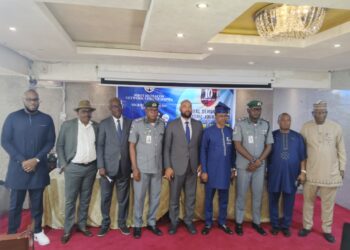By Jerome Michelet
Transshipment, or the transfer of fish from one vessel to another, is a vital part of the global commercial fishing industry. It touches a wide variety of seafood products, from bigeye and skipjack tuna all the way to mackerel and other pelagic fish, which are caught in the waters off West Africa.
Moving catch from fishing vessels onto a refrigerated cargo ship may seem like innocuous activity, but it often takes place at sea, far away from the scrutiny of coastal authorities. This gives unscrupulous operators an opportunity to falsify, manipulate, or conceal data related to their fishing practices. At-sea transshipment is widely prohibited in most countries in the Gulf of Guinea, an immense area covering most of the Atlantic African shores and touching 20 countries from Mauritania to Angola. The region is famous for its rich fishing grounds and for the lack of fisheries monitoring.
However, Global Fishing Watch’s carrier vessel portal shows hundreds of carriers loitering, a behavior that can be associated with transshipment activity. A concentration of loitering activity can be found within the exclusive economic zones (EEZ) of several West African countries, including ones like Ghana or Côte d’Ivoire where transshipment at sea has been banned. Since vessels are not supposed to transship fish there, it raises the question as to why so many of them are stopping there in the first place.
Loitering reefers: a legal practice or a cover for illegal activity
Reefers, also known as carrier vessels, are refrigerated ships used by industrial fishing vessels to transship their catch, allowing fishers to spend more time fishing and less time transiting to port. While this practice seems to make economic and ecological sense, it has one major drawback: it may support illegal, unreported and unregulated (IUU) fishing. Transshipment can make both fishing activity and catch less traceable, which allows unscrupulous operators to further benefit from lax management of this activity. For this reason, many countries and regional fisheries management organizations (RFMOs) regulate the practice and require it to be well documented, such as through placement of independent fisheries observers to witness transshipment events.
A portal to observe encounters and loitering events
Global Fishing Watch has created a portal to analyze carriers’ behavior throughout the world. Based on automatic identification system (AIS) positions transmitted by the ships, the portal shows events where a reefer and a fishing vessel meet at slow speed for hours. This kind of encounter indicates the likely transshipment of fish. Additionally, since many fishing vessels do not use AIS, the algorithms track what we call “loitering events”, where a carrier remains at a slow speed in open waters for a period of time, despite the lack of any fishing vessel detected nearby; fishers may be present but unseen due to their AIS being turned off. Potential transshipments indicated by encounters and loitering events may or may not be legal, depending on relevant regulations and the presence of an observer, which the portal cannot assess. Since vessels carrying out legal events have nothing to hide, visible encounters could be assumed to be legal, while loitering events may be more likely to hint at risk and indicate that further investigation could be useful. We hope that this new portal will help curb unsustainable and illegal practices, whilst leveling the playing field for compliant behavior.
Big concentrations of loitering in the Gulf of Guinea
IUU fishing in the waters off West Africa, the worst affected region in the world, poses a threat to food and economic security, as well as seafood buyers, processors and retailers in the region. Since illicit transshipment activity enhances the profitability of IUU fishing, the practice in that region was investigated using the portal. The regulatory framework for at-sea transshipments in coastal State waters in the Gulf of Guinea region is complex; in some countries, transshipment is only allowed to occur in port; elsewhere, it is authorized but under certain conditions, including the requirement of observers monitoring the activity. Counting all events in Atlantic African EEZs between Jan. 1, 2017 and Aug 31st 2020, I found a total of only 241 encounters between carrier and visible fishing vessels, but a striking 4309 loitering events by carriers.
Carriers, like all merchant ships, make money by carrying their cargo to the next port. During loitering events, the ship remains idle instead of progressing towards its destination. There must be a specific reason to explain this loss of time. In the Gulf of Guinea region, the reasons can include undertaking transshipment activity, awaiting access to a port, waiting for access to a high-risk piracy area, getting fuel at sea (which can also be unauthorized), maintenance, or simply awaiting a change in company orders. Therefore, it is important that these events are made visible to the relevant authorities so suspicious activity that may suggest hidden transshipment activity can be investigated.
I explored which EEZs are affected the most frequently by these events. Four areas of high average levels of loitering activity can be seen.
3.4 events per week in Angola
2.8 events per week in Ghana (and 1.7 more in the adjacent Côte d’Ivoire)
2.1 events per week in Guinea Bissau
2.2 events per week in Mauritania, which is the only place in the region where actual encounters are routinely visible, with 1.1 encounters per week.
The coincidence between loitering events and the richest fishing grounds calls for deeper investigation.
How does this compare to the rest of the world? A total of 80,029 loitering events and 23,464 encounters were spotted around the world by our algorithms over three years and half. In other words, on a global scale, there is a ratio of 3.4 loitering events for each encounter. If we look at the EEZs between Gibraltar and South Africa, excluding Mauritania, the ratio jumps to more than 91 loitering events for every encounter. It is unclear why carriers would need to spend this amount of time loitering at sea, much more than elsewhere. An explanation for this striking difference could be due to a large amount of port stops, piracy risks or oil transfer. However, the excess loitering may also represent encounters with IUU fishers. This is a hypothesis I would like to investigate with the fishing agencies of the affected countries. To aid this, we are looking into the shipping patterns on the water to try and eliminate low-risk events and highlight the most suspicious activity worth investigating.
Transparency in transshipment
Most companies want to ensure their business is not supporting illegal practices. By reporting on AIS whilst conducting all transshipment events, industry can demonstrate both legality and compliance with relevant regulations and raise the bar when it comes to transshipment reform. To minimize the risk of illegal activity occurring, ideally all authorized transshipments should be made public so the proper due diligence can be carried out by port States, flag States and coastal States. Additionally, if coastal States required AIS on all industrial fishing vessels, it would allow all actors to better see when and where reefers encounter fishers at sea.
With this portal, our team at Global Fishing Watch aims to shine a light on potential transshipment events and potential carrier activities that are often conducted out of sight, enabling legal actors to demonstrate compliance through transparency.
Jerome Michelet is a regional director for the transparency program at Global Fishing Watch.
































































